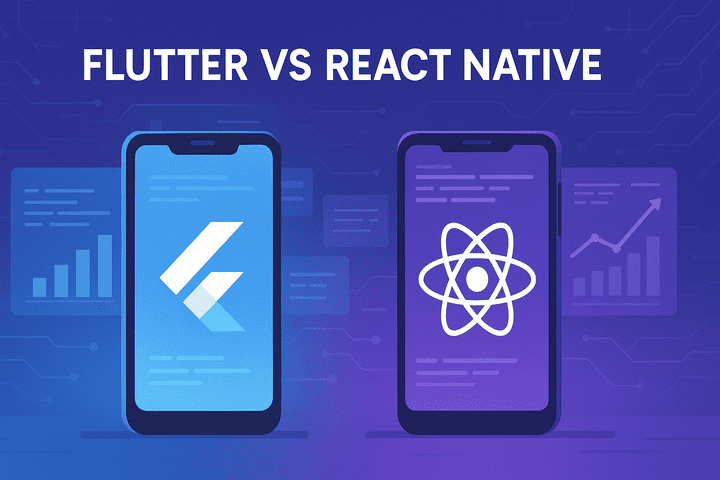Flutter vs React Native: In-Depth Performance & Ecosystem Comparison
ASOasis Tech Private Limited
4 min read

Table of Contents
Introduction
Cross-platform frameworks Flutter and React Native empower developers to build native-like mobile applications from a single codebase. In this article, we explore their performance characteristics, architectural differences, ecosystem strengths, and ideal use cases to help you make an informed choice.
Why Choose Flutter?
- Consistent Rendering Engine
Flutter uses Skia (and Impeller on newer versions) to draw every pixel, ensuring identical UI across Android and iOS. - Compiled to Native Code
Dart is AOT-compiled to ARM or x86 libraries, delivering 60+ FPS in most scenarios. - Rich Widget Library
Over 25 prebuilt Material and Cupertino widgets for seamless design fidelity. - Strong Tooling
Integratedflutter doctor, DevTools profiling, and built-in hot reload.
Why Choose React Native?
- JavaScript Ecosystem
Leverage millions of npm packages, familiar syntax, and a large talent pool. - Native Component Mapping
Renders true native UI components for each platform. - JSI & TurboModules
Modern architecture reduces bridge overhead and boosts startup times. - Expo & CLI
Quick project scaffolding with Expo, plus ejectable bare workflow for native modules.
Key Features
1. Rendering & UI
- Flutter: Full control via Canvas – pixel-perfect, custom animations.
- React Native: Leverages platform-native widgets – look and feel are inherently native.
2. Performance Profiling
- Flutter DevTools: Frame rendering timeline, memory allocation, and CPU sampling.
- React Native + Flipper: Network inspector, layout debugging, and performance monitors.
3. State Management
- Flutter: Provider, Riverpod, Bloc, and GetX patterns in Dart.
- React Native: Redux, MobX, Recoil, and Context API in JavaScript/TypeScript.
4. Hot Reload / Fast Refresh
- Flutter Hot Reload: Sub-second UI updates, preserves state.
- React Native Fast Refresh: Reliable code push for UI & logic changes without full reload.
Getting Started
Install Prerequisites
- Flutter: Download SDK and set
PATH. - React Native: Install Node.js, Watchman (macOS), and React Native CLI.
- Flutter: Download SDK and set
Create a New Project
# Flutter flutter create my_flutter_app # React Native npx react-native init MyRNAppRun on Simulator / Device
# Flutter cd my_flutter_app && flutter run # React Native cd MyRNApp && npx react-native run-android npx react-native run-iosEnable Hot Reload / Fast Refresh
- Flutter: Press “r” in terminal during
flutter run. - React Native: Enable Fast Refresh in the React Native Dev Menu.
- Flutter: Press “r” in terminal during
Integration & Ecosystem
Package Management
- Flutter:
pub.dev - React Native:
npm/yarn
- Flutter:
Official Plugins
- Flutter: camera, geolocator, firebase_core
- React Native: @react-native-community/netinfo, react-native-async-storage
CI/CD Options
- Flutter: Codemagic, GitHub Actions with
flutter build - React Native: Fastlane, Bitrise with native build steps
- Flutter: Codemagic, GitHub Actions with
Over-the-Air Updates
- Flutter: Needs full rebuild; some third-party solutions exist
- React Native: Microsoft CodePush for JS bundle updates
User Interface Overview
Flutter Widgets Compose UI from nested widgets; complete control over rendering.
React Native Components Use
<View>,<Text>,<Image>mapped to native views.Layout System Both use Flexbox for responsive layouts; Flutter adds
Row/Columnabstractions.Styling
- Flutter: Dart-based style properties.
- React Native: JavaScript StyleSheet or styled-components.
Popular Use Cases
- Graphics-Intensive Apps Flutter’s Skia engine excels at custom animations and games.
- Rapid Prototyping React Native with Expo allows quick proofs-of-concept without native code.
- Enterprise Solutions Both frameworks power high-scale apps (e-commerce, finance, logistics).
- MVPs & Startups Shared codebase reduces time-to-market and maintenance overhead.
Security & Considerations
- Code Auditing
Review third-party packages for vulnerabilities (npm audit,
dependency_validator). - Performance Monitoring Integrate Sentry, Firebase Performance Monitoring, or custom logging.
- Platform-Specific Permissions Configure AndroidManifest.xml and Info.plist carefully for each plugin.
Cost & Licensing
- Open Source Both Flutter and React Native are MIT-licensed, free for commercial use.
- Community & Corporate Support Backed by Google and Meta, respectively, with vibrant community forums and official roadmaps.
- Consulting & Training Numerous third-party providers offer enterprise support and training programs.
Conclusion
- Flutter is ideal for performance-critical, visually rich applications where consistent UI matters.
- React Native suits teams with strong JavaScript skills seeking rapid development and a vast package ecosystem. Evaluate your project requirements, team expertise, and long-term maintenance goals when choosing between these frameworks.
Resources
- Flutter Official Site: flutter.dev
- React Native Official Site: reactnative.dev
- Performance Benchmarks: GitHub Repository
- Stack Overflow Developer Survey: Stack Overflow Insights
- Pub.dev Packages: pub.dev